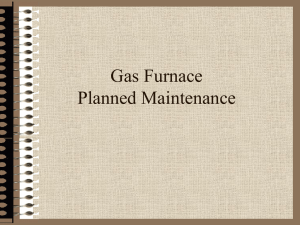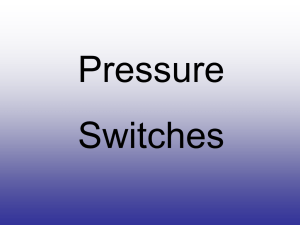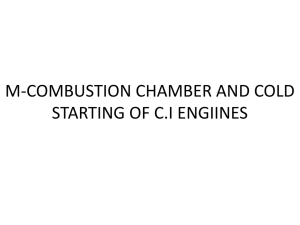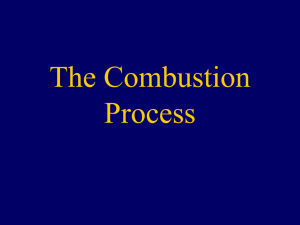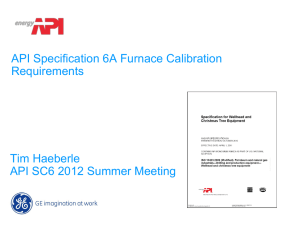HVAC Preventative Maintenance Joe Marchese
advertisement
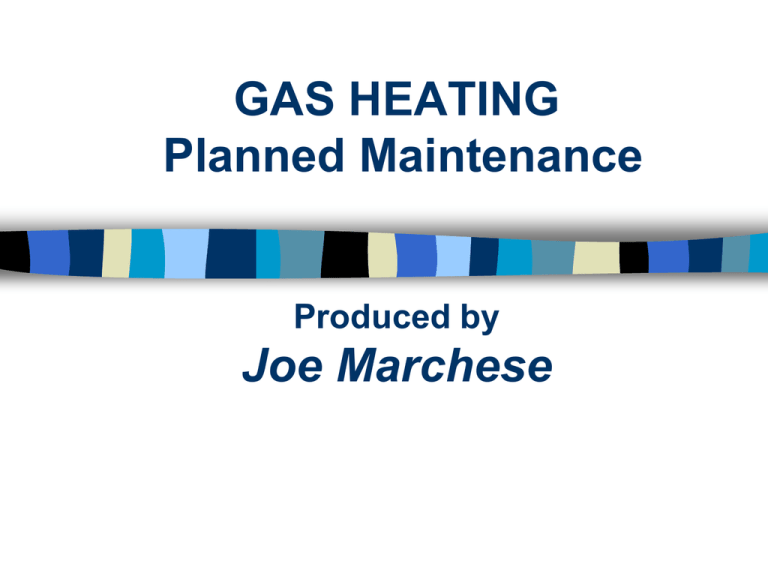
GAS HEATING Planned Maintenance Produced by Joe Marchese Personal Safety Good safety practices will prevent many injures Safety must be first on your mind at all times Always remove loose items when working around equipment with moving or rotating parts Be cautious of sharp objects Personal Safety Always lift with your legs and not with your back Wear a back support belt when lifting heavy objects When working with electrical equipment always verify that the power is off Do not rely on a shut-off switch or disconnect being off -- always check yourself Personal Safety Be cautious of hot surfaces or work areas Be cautious of any gas or oil leaks Always check for carbon monoxide Always follow proper safety practices when working with ladders Be cautious of confined spaces provide proper ventilation when required Personal Safety Equipment Safety Shoes Safety Goggles Gloves Pocket Voltage Detector Back Support Belt Oil Absorbent Personal CO Detector Why Perform Planned Maintenance? To reduce equipment failures To keep equipment operating in a safe manner To keep equipment performing at peak efficiencies To maintain good indoor air quality What is the most important concern for a service technician while performing a preventive maintenance inspection? SAFETY Safety Carbon monoxide poisoning is a major concern Natural gas leaks can create a serious hazard Fire as a result of damaged or bypassed safety controls Lack of heat from improperly operating furnaces Keeping Equipment at Peak Efficiency Poor electrical connections can cause the system to work harder Improper gas combustion will decrease the efficiency of a gas-fired furnace Dirty filters will reduce the airflow through a system which will decrease the system’s efficiencies Indoor Air Quality Humidifiers that are not operating properly can lead to poor indoor air quality Filters not maintained can lead to poor indoor air quality Carbon monoxide leaking into a structure is a serious indoor air quality issue How Long Should a PM Inspection Take? Depends on: – the type of equipment – the detail in which the inspection is performed SHORT INSPECTION vs. LONG INSPECTION What Are the Most Important Tools Used on a PM Inspection? Your hands Your eyes Your ears Your nose First Steps Determine the type of furnace – Barometric - standing pilot – Barometric - direct spark Ignition – Induced draft - DSI or hot surface ignition – High efficiency - sealed combustion Maintenance Task Items Always following the equipment manufacturer’s guidelines Tasks can be grouped into four major categories: – – – – Inspection Cleaning Lubrication Operation checks Maintenance Task Items Check availability of combustion air (80% furnaces only) Clean and inspect air system accessories such as humidifiers and electronic air cleaners Check the condition of the electrical wiring and tightness of the terminals and connectors Clean or replace air filters Maintenance Task Items Clean and inspect fan compartment Clean and inspect the condensate drain system (90% furnaces only) Clean and inspect the vent system Clean and inspect burners and heat exchanger Maintenance Task Items Check thermostat and heat anticipator or cycle switch settings Check sequence of operation Check pilot/burner operation Perform combustion tests Check temperature rise Check safety controls Combustion Air Different furnace designs will have different styles to bring combustion air into a furnace. An 80% efficient furnace normally uses the air surrounding the furnace for its combustion air A 90% plus furnace normally uses outside air for its combustion air Combustion Air When performing an inspection the location of the furnace should be examined to make sure it has a sufficient volume to provide enough combustion air Make sure no other gas-fired appliances (such as a dryer or hot water heater) steal combustion air from the furnace Combustion Air Verify that the combustion air will not be contaminated by halogen compounds, such as fluoride, chloride, bromide and iodide vapor. If installed in a laundry room, make sure the exhausted products vented by the dryer do not enter the furnace and are used for combustion air Unconfined Space An unconfined spaced has a volume of at least 50 cubic feet per 1000 Btus input total for all appliances located in the space If the unconfined space is constructed unusually tight, the combustion air must come from outside air or from spaces freely communicating with the outdoors Confined Spaces A confined space has a volume less than 50 cubic feet per foot per 1000 Btus of total input rating of all appliances installed in that space There must be provisions for supplying combustion air; it can be ducted in from outdoors or from an unconfined space Confined Spaces The number of openings and the size of the openings will depend on whether the air comes from the outside or from adjoining unconfined space Combustion Air Requirements If combustion air is brought from within the structure there must be 2 openings – Each opening must have a minimum free area of not less than 1 square inch per 1000 Btu of total input rating for all gas appliances in the space (should not be less than 100 square inches) If construction is unusually tight, outside air must be brought in Combustion Air Requirements If combustion air is brought from outside the structure there must also be 2 openings, however: – If two vertical ducts are used they must have at least 1 square inch of free area per 4000 Btus of total input for all gas appliances – If two horizontal ducts are used they must have at least 1 square inch of free area per 2000 Btus of total input for all gas appliances Combustion Air Requirements A single opening can be used if it has a free area of 1 square inch per 3000 Btus of total input for all gas appliances Failure to comply with these guidelines may result in a furnace starved for combustion air which could lead to the formation of carbon monoxide Cleaning and Inspecting Air System Accessories Humidifiers Maintenance required: Replace media pad Clean mineral deposits from: – water reservoir or drain pan – float, float valve orifice, and valve seat – water solenoid valve orifice and strainer Humidifiers Maintenance required: Check for water overflow On wheel-type humidifiers, an approved water treatment solvent can be applied to water reservoir If a bypass humidifier is used, make sure the dampers are open for winter operation Recommended Indoor Humidity Levels at Various Outdoor Temperatures AT OUTDOOR TEMPERATURE (F) RECOMMENDED INDOOR RH (%) -20 15 -10 20 0 25 10 30 20 35 30 40 Electronic Air Cleaners Maintenance required: Turn voltage off to unit (9,000 to 11,000 VDC supplied by cleaner’s transformer) Remove the pre-filters and air cleaner cells Clean inside of cabinet Clean pre-filters with a mild soap solution Electronic Air Cleaners Maintenance required: Wash air cleaner cells with a solution of 3/4 cup of dishwasher detergent and hot water Vinegar can also be used to clean cells Soak cells in solution for 15 to 20 minutes Rinse until all the solution is removed Electronic Air Cleaners Maintenance required: Inspect cells for any damage and reinstall with pre-filters Leave system’s blower on for 30 minutes with power off to air cleaner to dry the cells thoroughly Heat Recovery Ventilators Maintenance required: Filters should be changed monthly and interior blower maintained on the same schedule as the furnace Drain pans and interior of unit: – Clean interior surface and wipe the drain pans with a soft cloth and a mild cleaning solution – Check condensate drain Heat Recovery Ventilators Maintenance required: Heat Recovery Cores: – Remove from unit – Use warm water and a mild soap – Soak recovery core in solution for about three hours – Allow to dry before reinstalling Electrical Connections Turn off voltage applied to the furnace Make a visual inspection of all wire terminals and wires – Check for discoloration – Check for frayed or damaged insulation – Check for any loose connections and retighten all accessible screw terminals if needed – Check fuse holders for tightness, if applicable Air Filters Maintenance required: Can be either cleaned or replaced, depending on type A clogged or dirty air filter will result in the system going off on its high temperature safety limit, resulting in poor heating of the conditioned space Make sure to install air filters in the correct direction of airflow Air Filters Some owners may choose to replace their own filters or have their in-house maintenance personnel install the filters There are many different types of filters available -- notify the customer of the various types so the best filter can be selected for the job Fan Compartment Check blower wheel for dirt build-up and clean when required – An important maintenance task – Dirt on blower wheel will reduce CFM delivered by fan – This may be a time-consuming task – May require removing entire drive assembly Fan Compartment (Direct Driven Blowers) Visually inspect fan motor for bearing wear by spinning fan wheel and notice how it slows down and stops Check fan motor for excess end play – Some motors may have up to 1/8” end play Check motor bearing for “oval shape” – There should be no vertical play with shaft Lubricate motor, if required Fan Compartment (Belt Driven Blowers) Check belt tension for proper adjustment – 3/8” to 1/2” depression with a 10 lb. force If possible, use a belt tension gauge Visually inspect belt, bearing and pulley for signs of wear Visually inspect pulley and drive alignment – use straight edge or string Fan Compartment (Belt Driven Blowers) Check pulley and drive set screws for tightness Record belt size – When possible leave an extra belt on the job – Mark belt size on unit Lubricate motor and fan bearings, when possible – Some motors have sealed bearings and external lubrication is not needed Clean and Inspect Condensate Drain System Inspect condition of the condensate line Clear lines with compressed gas, if necessary Inspect condensate pump, remove and clean if required Condensate Pumps Maintenance required: Remove pump from system Remove reservoir from pump Clean reservoir of any dirt or grime and check float Reinstall Add water to system to check pumping operation Check Condition of the Vent System Inspect pipes for any cracks or weak spots Clean out chimney base if access door is provided If no access door is provided, remove a section of pipe and examine for any clogs or restrictions Verify the vent system is pitched toward the furnace 1/4” per foot Draft Diverters If the system has a draft diverter: Check for obstructions Check for signs of corrosion Lightly tap area to see if walls are rusted Cleaning and Inspection of Gas Burners Remove and clean burners, mainly multi-port burners only Mono-port burners require little cleaning Use a mild brush and shop vacuum Do not damage or enlarge ports while cleaning Cleaning of burners may not be needed on every inspection, but must be checked Cleaning and Inspection of Gas Burners Check burner alignment to ensure no flame impingement is occurring on the heat exchanger – Flame impingement will cause CO Make sure the burners are secure Check crossover tubes to ensure proper alignment Heat Exchangers Check for cracks Can be inspected for cracks in one of three ways: – Visual Method • Requires removing burners • The use of a good mirror and strong lamp • Difficult to perform – Air Flow Method – Test Gas Method Standing Pilot Systems Remove and clean pilot assembly, where required Do not clean orifice with an object that may change the size of the orifice opening Check and adjust pilot flame, if necessary Pilot Assemblies Pilot flame should impinge a height of 3/8” to 1/2” on the top of the thermocouple Thermocouples Two dissimilar metals are welded together at one end When one of the junctions is heated and the other end remains relatively cool, a low electric DC voltage is produced Thermocouples The voltage generated depends on the temperature difference between the hot and cold junctions Output Voltages Normal output voltage of an unloaded thermocouple is 26 to 32 milli-volts DC The minimum acceptable output voltage is 18 milli-volts DC Drop out time of the pilot solenoid should be within 2-1/2 minutes. Direct Ignition (Hot Surface Igniter) Hot surface igniter directly lights burners Made of ceramic Is very fragile Uses flame rectification circuit Direct Ignition (Hot Surface Igniter) During preventive maintenance inspections, visually inspect for cracks or breaks At room temperature the resistance should equal 45 to 90 ohms (if over 110 ohms, replace) Thermostats On mechanical thermostats check: – That the thermostat is level – That the heating anticipator setting is properly set – That the temperature gauge on the thermostat is within 2°F of actual temperature of the living space Electronic thermostats only require checking the accuracy of the temperature gauge Heating Anticipators Wired in series with the controller contacts Set to match the amperage draw of the heating controls Too low of a setting will cause the on cycle to be too short Too high of a setting will cause the on cycle to be too long Sequence of Operation A major part of a preventive maintenance inspection is checking the sequence of operation of a furnace Necessary to verify the furnace is operating safely and efficiently Different furnace types will have varying sequences of operation Intermittent Pilot Furnaces Sequence of operation: Thermostat calls for heat Spark is generated to light pilot Once pilot flame is proven, the gas valve opens and flame is produced After a delay the indoor blower is turned on Standing Pilot Natural Draft Sequence of operation: Thermostat calls for heat Gas valve opens Burners are lit After a delay, based on air temperature the indoor blower motor will come on Standing Pilot Induced Draft Sequence of operation: Thermostat calls for heat Induced draft blower comes on Once draft has been proven, the gas valve opens and flame is produced and the flame is proved Indoor blower is turned on after a delay Direct Ignition Condensing Furnace Sequence of operation: Thermostat calls for heat Induced draft blower comes on Once the induced draft blower builds a negative pressure in the blower housing, the differential pressure switch closes Hot surface igniter is energized Direct Ignition Condensing Furnace Sequence of operation (cont.): After a delay the gas valve opens and flame is produced Once the flame is proved, the gas valve will remain energized Indoor blower is turned on after a delay Check & Record Manifold Gas Pressure Compare with manufacturer’s specifications Normally natural gas is 3.5” w.c. at the outlet of the gas valve Normally LP is 11” at the outlet of the gas valve Flame Color The flame should be a well-defined blue with slightly orange tips If yellow tips are observed, it is a sign of incomplete combustion and the cause should be found and rectified A yellow-tipped flame is producing CO which is not a desired result of combustion Flame Conditions Problem Cause Remedy Lifting Flame Too much primary air Gas pressure too high Incorrect orifice Decrease primary air Reduce gas pressure Check and replace if needed Yellow Tipping Shortage of primary air Increase primary air Shortage of total combustion air Clean burner Incorrect orifice Check and replace if needed Flame Conditions Problem Flashback Extinction Pop Wavering Flames Cause Remedy Primary airflow too Decrease high primary air Gas flow is too low Check gas input Replace burner Defective gas Replace gas valve valve Drafts in combustion chamber Cracked heat exchanger Check furnace panels Replace Flame Conditions Problem Delayed Ignition Cause Remedy Improper gas pressure Slow opening gas valve Misdirected pilot flame Adjust gas pressure Replace gas valve Redirect Dirty orifice or burners Clean Drafts across the burners Check furnace panels Flame Rollout Shortage of combustion air Check for blockage Combustion Testing Combustion Efficiency Measuring the CO2 and flue gas temperature is a means of determining the combustion efficiency Steady state efficiency is the point at which combustion gas content reaches equilibrium and the stack temperatures stabilize Combustion Tests Measure ambient temperature and the stack temperature to obtain the net stack temperature Measure draft pressure Measure the carbon dioxide(CO2) level Measure the oxygen (O2)level Measure the carbon monoxide (CO) level Category I Appliance Fan Assisted Furnaces Category I Appliance Test Points Category IV Appliances Checking Airflow Tested by measuring the temperature rise across the heat exchanger Generally low-efficiency furnaces will have a temperature rise of 75°F to 100°F Generally high-efficiency furnaces will have a temperature rise of 40°F to 70°F Always look on the data plate of the furnace for the correct range Temperature Rise Always check the supply air temperature out of the line of sight of the heat exchanger, and the return air temperature as close as possible to the heat exchanger Before checking the temperature rise of a furnace, make sure the filter is clean and the airflow is not being restricted Temperature Rise All registers and dampers must be open The system should be operating for at least 15 minutes Use the same type thermometer for measuring the supply and return temperatures Before checking the temperature rise, compare the accuracy of thermometers Temperature Rise A temperature rise that is higher than the range stated on the furnace indicates a shortage of airflow across the heat exchanger A temperature rise that is lower than the range stated on the furnace indicates too much airflow across the heat exchanger Adjusting the Fan Speed A direct drive blower’s fan speeds can usually be changed by selecting the appropriate speed tap Common Color Coding: • White = common • Black = high speed • Yellow = medium high speed • Blue = medium low speed • Red = low speed Adjusting the Fan Speed Belt-driven blowers can usually be adjusted by changing the flange on the motor pulley – Adjusting the pulley flange towards the fixed flange will increase the speed of the blower Sometimes the pulley will need to be changed, using the formula: Diameter(drive) = Diameter(driven) X (rpm(fan)/rpm(motor)) On belt driven fans always check the amperage draw of the motor after making any adjust to the fan speed Safety Controls Checks Verify the operation of the high temperature switch Block return airflow completely and observe the gas valve shutting down On induced draft furnaces, remove one end of the rubber hose from the air pressure switch and observe the gas valve shutting down THE END
